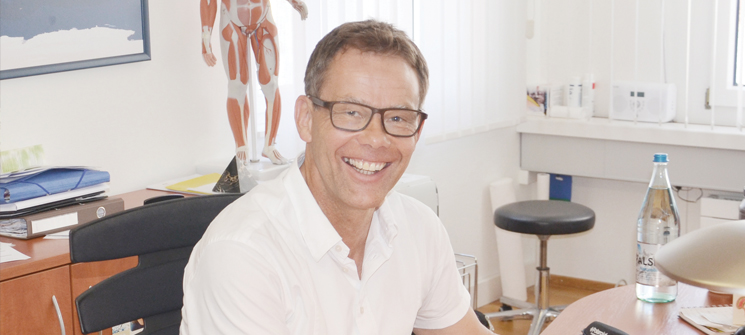


Treatments using vitamins and minerals are not a new-age myth, but a very effective way to improve health and tackle many health problems. In the Grand Resort Bad Ragaz medical center, this unique line of work, which has been christened «orthomolecular medicine», is headed by the doctor of medical sciences Dr. Christian Hoppe.
– Dr. Hoppe, could you briefly explain what I orthomolecular medicine is?
– Well, briefly, it is a doctrine of micronutrients. The macronutrients are fats, proteins and carbohydrates, and the micronutrients are vitamins, minerals, amino acids, and fatty acids. Orthomolecular medicine is a whole field of medical knowledge. Two Nobel laureates have received awards for research in this field.
– What is your approach to treatment with micronutrients?
– The idea is an individual focus of treatment. Until now, in most clinics doctors have prescribed vitamins and other micronutrients for their patients blindly, without a preliminary examination (which should include a study of blood, saliva or a feces analysis in scatology). But in such a case we cannot be sure ofthe effectiveness of the treatment, because it has been conducted without taking into account the individual characteristics ofthe physiology of that particular person. It is likely that a combination of mineral substances prescribed blindly will not include the exact micronutrients that the patient needs most.
Moreover, with this approach it is possible to violate the main principle of medicine – to do no harm – if the dosage is too small or too large, and this is unacceptable. Therefore we always recommend a full diagnosis for a patient and only then, based on the results of the analysis, do we devise an individual treatment program with micronutrients.
– How is the diagnosis carried out?
– First of all, it is based on special laboratory studies that measure the amount of micronutrients not only in the blood serum but also inside the cells. ^ere is also a coprological study, which takes more time – the results are ready after about three weeks.
This is a fairly new field of knowledge, although about 6,000 studies on this topic are published annually. The fact is that millions of bacteria live in our body and they haven’t yet been properly studied, and therefore we are still expecting new discoveries in this field.
Of course, the patient will not be able to get recommendations for treatment after just one visit to the doctor; that’s simply not possible. He will have to come to us twice, for diagnosis and then for treatment. The necessary combination of nutrients and recommendations for their use will be ready by his second visit.

– But could the recommendations be sent by e-mail?
– Theoretically, yes. However, recommendations are not enough. We also provide patients with counselling: we explain how to manage stress, and we develop a set of physical exercises that enhance muscle activity. It is necessary for people to understand that if you just take a pill, the problems will not disappear. Micronutrients are only a part of the therapy, albeit a very important part.
One of the most serious problems today is inadequate nutrition. Of course, we hear that it’s not like that: that now, on the contrary, healthy food has become very popular, that stores are opening in which not only fresh but also ecologically pure products are sold. This is true, and it’s good that the media is promoting a healthy lifestyle, including proper nutrition. But the fact remains that almost every day I see patients of different ages who have all the signs of lack of vitamins, minerals, and micronutrients, and these are wealthy people, who are able to monitor their health and buy good quality fresh products. What does this say about other, poorer people?
– Which micronutrients are most often lacking?
– A classic example is vitamin D, especially in Europe and especially in the winter months. This applies more to the residents of big cities, where there is not enough flora and greenery. People spend almost all their time indoors and they do not produce vitamin D. Then there is iron deficiency, which is more common in young women.
The lack of these two necessary components leads to problems such as sleep disorders, depression, and deterioration of quality of life in general. Isn’t it bizarre that very young people start using antidepressants? Instead of slightly adjusting their levels of vitamin D or iron, they are prescribed the strongest medications; these can be prescribed for up to six months and they just cause greater harm to health!
– I know that an equally serious problem is a lack of vitamin B12. For which category of people is this most common?
– A deficiency of vitamin B12 is most common in the elderly, but this depends largely on the individual characteristics of the body. Some people feel great if their level of vitamin B12 is at the upper limit, while others, on the contrary, feel great if it is close to the lower limit. ^erefore, for me, as a doctor, it is important not only to have the results of laboratory investigations on hand but also to see the patient, to know as much as possible about him, and to ask in detail about problems with his well-being. Only after that can I put together the necessary combination.
Unfortunately, due to the fact that micronutrients are becoming more popular today, the number of so-called «experts» who do not have the appropriate education and professional qualifications in this area is increasing. ^ey conduct laboratory investigations, but when it comes to the correct interpretation of the results, they lack experience and knowledge. Moreover, in many countries, doctors do not pay much attention to such indicators and do not consider the situation to be serious, and so the patient becomes less anxious and gets used to his condition – and his quality oflife worsens.

– Is it possible to get advice on nutrition during a consultation? What, for example, should be included in one’s diet in order to replenish the levels of missing trace elements?
– Again, it is possible only after a complete examination which, in addition to traditional analysis, includes measurement of the percentage of adipose tissue, analysis ofbody composition, ECG with exercise, and assessment of the lungs and heart. ttis is the basis for determining further treatment, so the doctor should prescribe a general examination, determine the general health risks, and listen to the patient’s complaints.
The aim of the therapy is firstly to reduce health risks, secondly to improve one’s working capacity, and thirdly (the most important for me), to help the patient develop a feeling of satisfaction with the state of his health. All this cannot be achieved by just giving a person a mixture of micronutrients. If, for example, you eat properly but do not sleep well at night, your health will not improve.
– So everything becomes clear with the diagnosis. How long can the treatment itself take?
–the course of therapy usually lasts 3 to 6 months, and then we conduct a second test. If there is any progress, you can continue working in the same direction but with a different dosage. This process, strictly speaking, is a lifelong thing. The goal is the preservation of vivacity, health and youth.
Other important aims are body cleansing (a detox module) and weight loss – here we offer programs of one week or more. Both of them, of course, start with an examination of the patient.
A detox program includes analysis of endogenous and exogenous toxins in a special detoxification laboratory, an ultrasound of the liver, cleansing of the gastrointestinal tract, and a consultation with a nutritionist who not only evaluates and gives a detailed analysis of dietary and food preferences, but also develops an individual cleansing diet. Doctors also devise a plan of special procedures such as lymphatic drainage, body massage, detoxification, daily Kneipp therapy in the thermal water of the Ragaz and, of course, personal recommendations for visits to the sauna, a fitness program, and relaxation sessions.
Thanks to this combination therapy, the body is completely cleansed and the patient becomes charged with vivacity, energy, vitality, and a strengthened immune system. This is due to the fact that as a result of detox procedures, metabolic blocks are destroyed and the optimal balance of the metabolism is restored.
– And what is special about your weight loss program?
– This program is very popular as people are becoming larger and larger every year, and often there is a deficiency of iron and vitamin D. It provides a comprehensive examination of various organs (liver, kidney, heart, and thyroid) and an analysis of the body’s composition and the patient’s diet. Then the nutritionists start to create an individual diet and develop a course of gradual weight loss. The program includes full board with meals (it’s necessary to drink two liters of Ragaz thermal water daily), as well as a starter package which includes whey protein isolate, L-carnitine and a mixture of multivitamins and minerals as a food supplement or food substitute.

– I would like to ask a question that interests many women. Is there a vitamin that slows down aging?
– Only unscrupulous doctors pick one element and promise: «By taking this, you will live longer and look younger». It is not going to work. It is just a business. But if you take a more serious approach to the problem and choose a complex of mineral nutrients, you really can live longer.
There are two types of anti-aging programs: «I want to live as long as possible» and «I’m 60, but I want to look like I’m 40». My theory is to stay healthy and, accordingly, live longer and better. As for rejuvenation and beauty, this is a field for beauticians. In my program, nutrients and nutrition are crucial. In this conversation, I have covered only a small part of such a broad topic as orthomolecular medicine. I am sure it is the future.

Christian Hoppe
Doctor of Medicine and Member of the Swiss Association of Physiotherapists and Rehabilitation Specialists. From 1989 to 1996 he studied at the Medical Faculty of the University of Bern. During his studies he worked in a psychiatric clinic at the University of Berne under the leadership of Dr. Kurt M. Bashman. In 2002, he received a doctorate in medicine.
Since 2004 he has specialized in the field of physiotherapy and rehabilitation medicine. He has experience of working as a sports doctor and chiropractor. From 2003 to 2006 he was a consultant at the Adelheid Rehabilitation and Recovery Clinic.
Since 2006, he has been a practicing physician at the Health Center of the Grand Resort Bad Ragaz and the leading doctor of the Swiss Olympic Medical Center (SOMC).
In 2008, he underwent training in orthomolecular medicine.